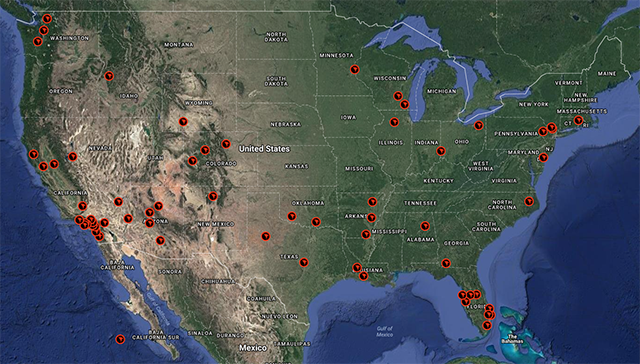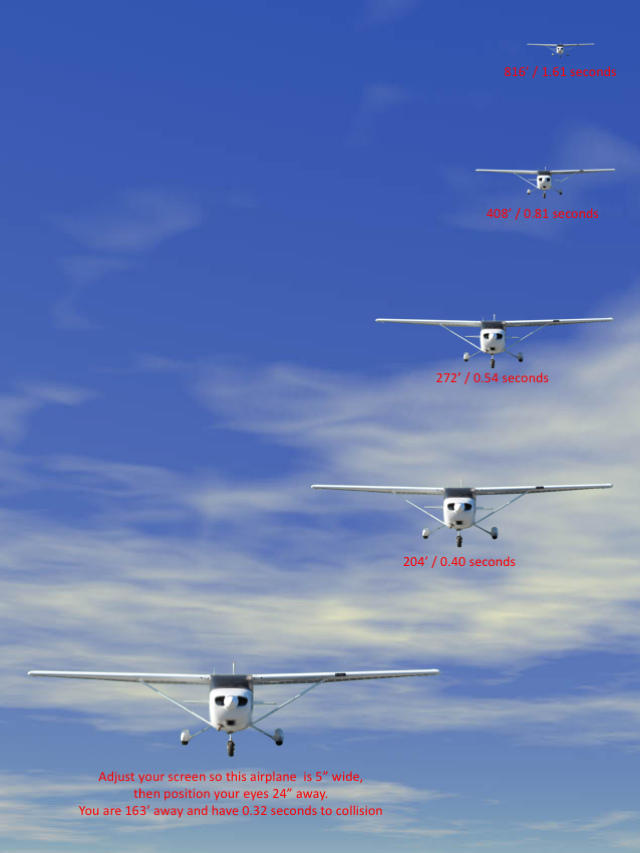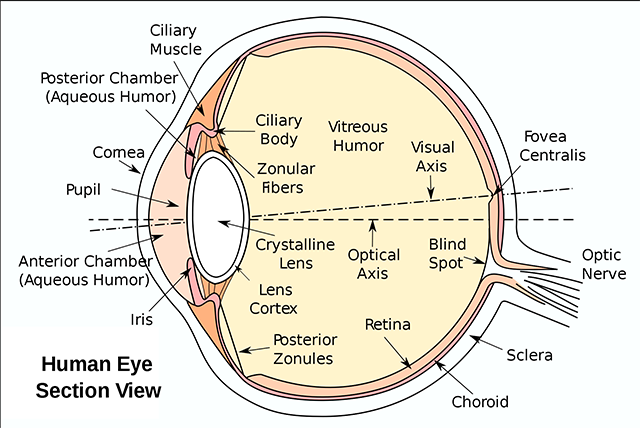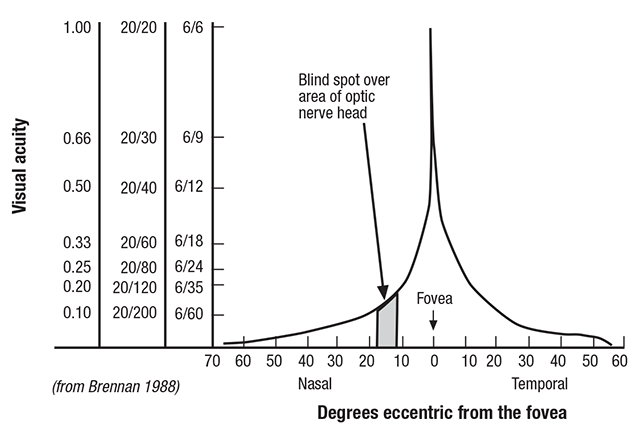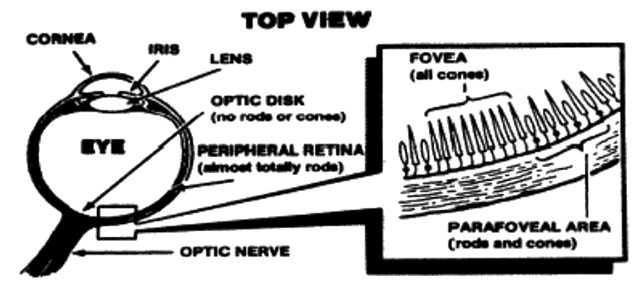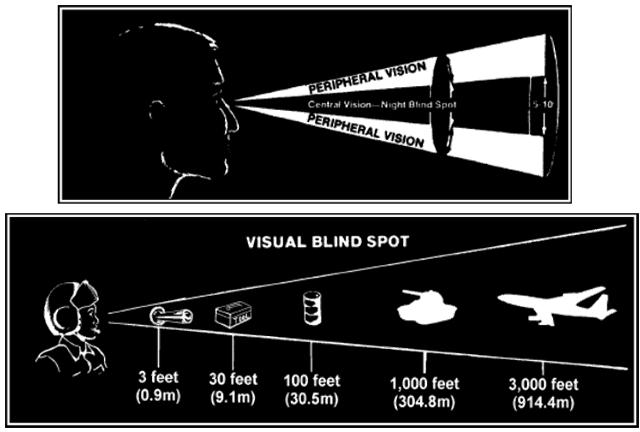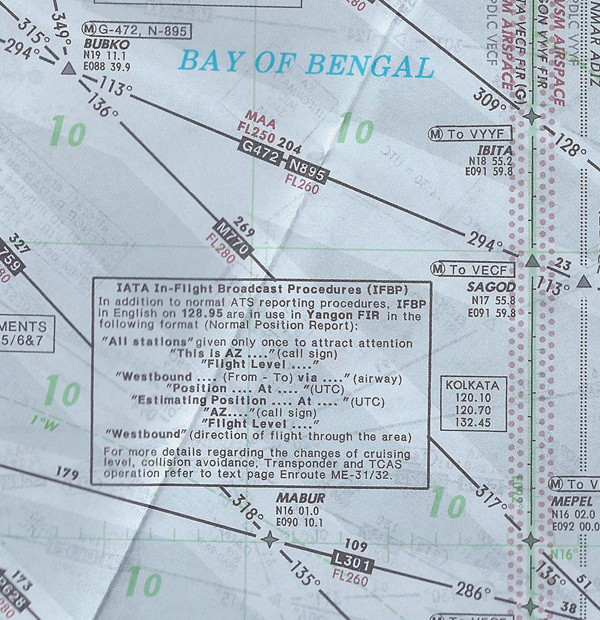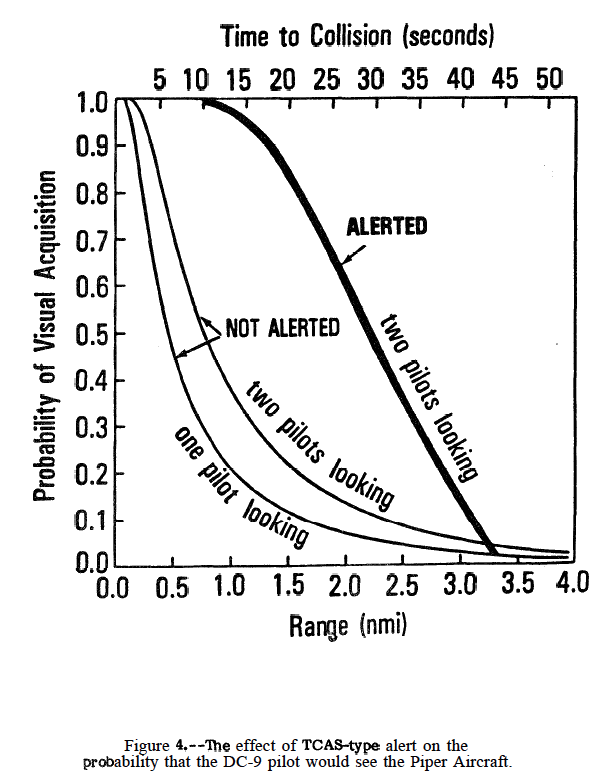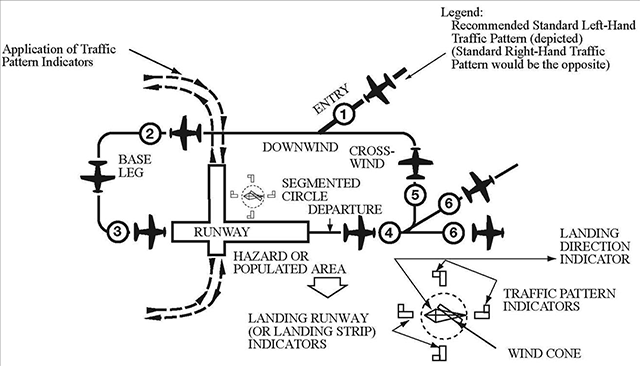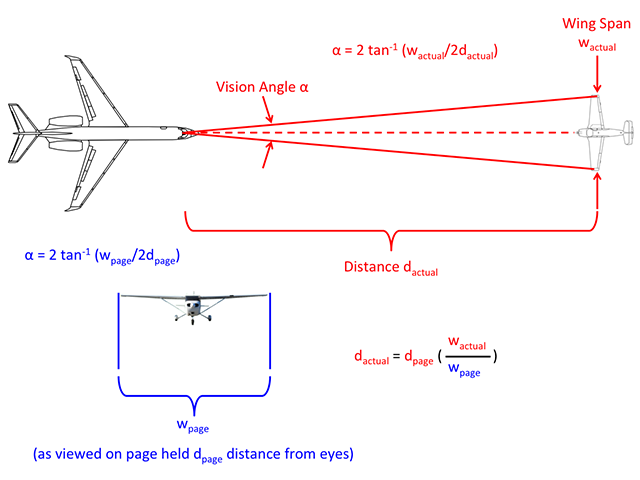It seems that there are a lot of pilots out there that believe in the "Big Sky Technique." They think the amount of airspace out there is so wide and vast, and that they are so small, that the chances of hitting another aircraft is too small to worry about. And yet history begs to differ.
— James Albright

Updated:
2024-07-01
The year before I started Air Force pilot training, my base experienced a midair between a low wing T-37 and a high wing light airplane. The two aircraft never saw each other, all aboard the smaller aircraft were killed. In that atmosphere I was taught the need to "keep your head on a swivel, keep your eyes outside." Over the next few years we lost a few more airplanes and while most of the military accepted that "you have to accept a few losses in a big operation," we continued to attack the problem with heads on swivels and eyes out of the cockpit.
Officially, we called it "clearing." I think most civilians call it "look out doctrine." I've always called it "the big sky theory," because you were betting your life on the hope the sky is big enough for everyone. But it isn't and you need to realize just how limited your ability to see a moving target is. If you have no choice but to fly into a hornet's nest, light the airplane up, fly a predictable route, use the radio, and, yes, head on a swivel and eyes out of the cockpit.
2 — The early history of the big sky theory
3 — The reason "see and avoid" often fails
6 — Improving "your" situational awareness
7 — Improving "their" situational awareness
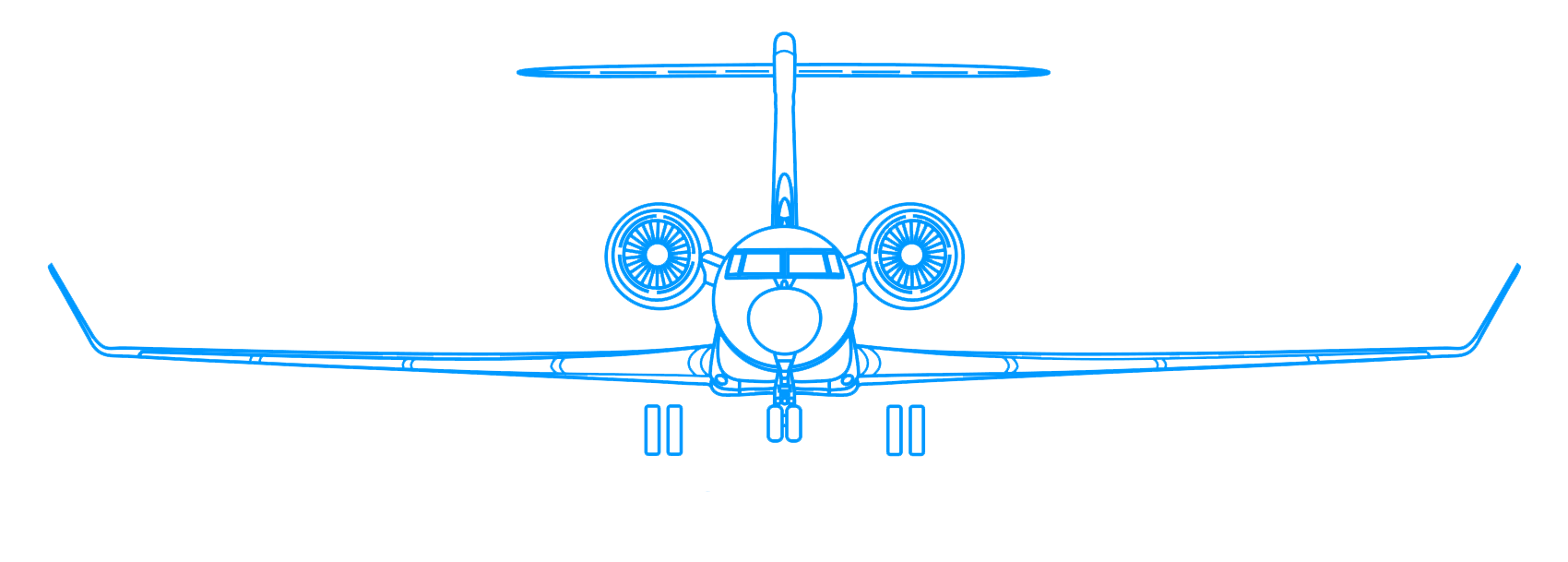
1
The threat
Where in the United States have there been non-military midair collisions?
Time to Impact
If you are facing another airplane "beak to beak," how long will it take to impact, based on how much of that airplane you can see?
The classic "beak to beak" midair collision scenario came from the Air Force in the seventies and featured an F-4 Phantom II heading right at you, the closure speed was on the order of 900 knots and you didn't stand a chance. Well let's make that more realistic so it applies to something you might actually see. Say, for example, you are flying an average business jet which normally flies 200 knots on downwind. (That's as fast as you are allowed to fly in most traffic patterns, after all.) You are at a non-towered airport and the airport directory says right-hand traffic is the norm. Now let's say a Cessna 172 pilot thinks it should be left hand traffic and also thinks flying at your pattern altitude is the thing to do. Now the two of you are flying "beak to beak," one at 200 knots and the other at 100 knots. This 300 knot closure speed is a third what the Air Force scenario used. So does that give you three times the time to impact?
It does indeed. But that still isn't enough time. As you will see below, it usually takes 12 seconds to acquire an aircraft visually (provided you know where to look), make a decision, and then to take evasive action. In our visual aid, above, if you are heading "beak to beak" and are not already maneuvering to avoid a collision, it is probably too late.
Where did these numbers come from? See: In Case You Were Wondering, below.
2
The early history of the big sky theory
The first powered flight took place on December 17, 1903 and the first midair was just seven years later.
- 1910: Antoinette IV & Farman III
- 1922: Compagnie des Grands Express Aeriens Farman F-60 F-GEAD & Daimler Hire Limited de Havilland DH-18A G-EAWO
We all intuitively understand that flying is a three-dimensional activity but we tend to only look straight ahead when clearing for other traffic. The first midair collision was the case of an airplane descending steeply into another. From this we should understand our eyes need to be where the airplane is headed and where other airplanes are likely to approach.
Many novice instrument pilots joke that "I Follow Roads" is what the non-instrument pilot will do. But in the early days of aviation, that was indeed the normal practice. The first midair of an airliner took place over a railroad track that was the common route between Croydon Airport, London and Le Bourget Airport, Paris. But the need to standardize rules between nations was not fully understood until this mishap.
3
The reason "see and avoid" often fails
The biggest limitation of the "See and Avoid" technique is the requirement to see. Perhaps a systems review of the "Mark One Eyeball" is in order.
- At the front of the eye is the cornea, a thick, transparent tissue that forms the outer coat of the eyeball and covers the iris, the colored part of the eye. The pupil, the circular opening in the center of the iris, allows light to enter the eye. The iris and pupil rest against the front of the lens, which is held in place by thousands of elastic fibers. These fibers, and the muscles to which they are attached, enable the lens, by changing shape, to focus on objects at varying distances.
- The retina, the inner layer of the back of the eye, contains more than 125 million light-sensitive receptor cells that receive information about an object being viewed.
- Rods and cones are the two main types of light-sensitive cells found in the retina. Rods, which are approximately 20 times more numerous than cones, respond to darkness, faint light, shape and movement. Thus rods, with their light-sensitive pigment (rhodospin), are responsible for adaptation to darkness (night vision) and perception of shades of gray.
- Cones, on the other hand, are stimulated by bright light and are responsible for our ability to perceive colors. Cones are concentrated in the highly sensitive central section of the retina, the fovea. Light entering the eye is focused directly on the fovea, making it the site of greatest visual acuity (sharpness of vision) and providing the ability to distinguish fine details.
- Visual acuity depends not only on the proper focusing of the image on the retina, but also on the ability of the retina to distinguish between objects that are extremely close together.
- In this area of maximum resolving power, there are approximately 170,000 receptor cells per square millimeter (10.6 million receptor cells per square inch). This vast number of receptors makes it possible to discern tightly spaced, minute objects as separate visual targets.
- The optic nerve, which consists of some one million nerve fibers, connects each eye to the brain and supplies blood to the retina. The retina transforms the information about the patterns of light and dark received by the rods and cones into electrical impulses that travel through the optic nerve to the brain, where they are interpreted as an image.
Source: Flight Safety Digest
Our eyes have a blind spot
The optic nerve is joined to the eye in the retina at a point called the optic disk. Because the optic nerve contains no light-sensitive receptor cells, it is considered “blind” and renders the optic disk blind, as well — creating the area commonly referred to as the “blind spot.” Normally, the blind spot is between five degrees and 10 degrees wide. The small size of the blind spot may make it sound insignificant, but it is enough to allow an aircraft to disappear from view, often before the eyes have detected it.
Source: Flight Safety Digest
The eye has an inbuilt blind-spot at the point where the optic nerve exits the eyeball. Under normal conditions of binocular vision the blind spot is not a problem as the area of the visual field falling on the blind spot of one eye will still be visible to the other eye. However, if the view from one eye is obstructed (for example by a window post), then objects in the blind spot of the remaining eye will be invisible. Bearing in mind that an aircraft on a collision course appears stationary in the visual field, the blind spot could potentially mask a conflicting aircraft.
Source: Limitations of the See-and-Avoid Principle, ¶2.5.1
Ideally our binocular vision can help make up for this blind spot but so can moving the direction of our scans.
Our field of view isn't as wide as it may seem
The shape of the eye and its position in our skulls limits the outward angles at which the eye can take in visual information. But just because an object is within this field of view doesn't mean it will be seen. Further, the angle itself decreases with age.
The average person has a field of vision of around 190 degrees, although field of vision varies from person to person and is generally greater for females than males (Leibowitz 1973). The field of vision begins to contract after about age 35.
Source: Limitations of the See-and-Avoid Principle, ¶2.2
Although our eyes accept light rays from an arc of nearly 200°, they are limited to a relatively narrow area (approximately 10 – 15°) in which they can actually focus on and classify an object. Anything perceived on the periphery must be brought into that narrow field to be identified.
Source: Collision Avoidance, pg. 7
Visual acuity is greatest for objects that are directly in front of the eye. But the fovea is a mere two degrees wide, which results in a very narrow high-acuity detection area and leaves as much as 178 degrees of the detection area in the realm of peripheral vision. This is one reason that we often tend to spot traffic or obstacles out of the “corner” of our eye.
Source: Flight Safety Digest
- The quality of vision varies across the visual field, largely in accord with the distribution on the retina of the two types of light sensitive cells, rods and cones. Cones provide sharp vision and colour perception in daylight illumination and are concentrated at the fovea, the central part of the retina on which an object appears if it is looked at directly. Rods are situated on the remainder of the retina surrounding the fovea on an area known as the peripheral retina. Although rods provide a black and white image of the visual field, they continue to operate at low light levels when the cones have ceased to function.
- Vision can be considered to consist of two distinct systems, peripheral and foveal vision. Some important differences between the two systems are that colour perception and the detection of slow movement are best at the fovea, while detection of rapid movement is best in the periphery. In daylight, acuity (sharpness of vision) is greatest at the fovea, but with low light levels such as twilight, acuity is fairly equal across the whole retina. At night, acuity is greatest in the peripheral retina.
- As figure 5 shows, acuity in daylight is dramatically reduced away from the direct line of sight, therefore a pilot must look at or near a target to have a good chance of detecting it.
Source: Limitations of the See-and-Avoid Principle, ¶2.2
In daylight, you need to look right at an object to see it; at night, you need to look slightly askance.
It is hard to focus on nothing
Motion or contrast is needed to attract the eyes’ attention, and the field of vision limitation can be compounded by the fact that at a distance an aircraft on a steady collision course will appear to be motionless. The aircraft will remain in a seemingly stationary position, without appearing to move or to grow in size, for a relatively long time, and then suddenly bloom into a huge mass, almost filling up one of the windows.
Source: Collision Avoidance, pg. 8
The greatest threat comes from those stationary targets, they are headed right for you. If you want to see them, you must focus on something at a distance:
When the eye has nothing to specifically focus on, which happens at very high altitudes, but also at lower levels on vague, colourless days above a haze or cloud layer with no distinct horizon, people experience something known as ‘empty-field myopia’, and opposing traffic entering the visual field is just not seen.
Source: Collision Avoidance, pg. 7
When we have nothing to focus on, we tend to focus on short distances
In the absence of a visual stimulus (for example, empty airspace), the muscles in the eye relax, preventing the lens from focusing. This creates a problem for a pilot who is attempting to scan for traffic in a clear, featureless sky. Because the eye cannot properly focus on empty space, it remains in a state of unfocused, or blurred, vision. This phenomenon, known as “empty-field myopia,” hinders effective search and detection.
Source: Flight Safety Digest
- In the absence of visual cues, the eye will focus at a relatively short distance. In the dark the eye focuses at around 50 cm. In an empty field such as blue sky, the eye will focus at around 56 cm (Roscoe and Hull 1982). This effect is known as empty field myopia and can reduce the chance of identifying a distant object.
- Because the natural focus point (or dark focus) is around half a metre away, it requires an effort to focus at greater distances, particularly in the absence of visual cues. However, the ability to accommodate to greater distances can be improved by training (Roscoe and Couchman 1987).
Source: Limitations of the See-and-Avoid Principle, ¶2.5.4
The human eyes tend to focus somewhere, even in a featureless sky. If there is nothing specific on which to focus, your eyes revert to a relaxed intermediate focal distance (10 to 30 feet). This means that you are looking without actually seeing anything, which is dangerous. In order to be most effective, the pilot should shift glances and refocus at intervals. Most pilots do this in the process of scanning the instrument panel, but it is also important to focus outside to set up the visual system for effective target acquisition.
Source: AC 90-48D, ¶4.2.2.
There is some dispute on just how far away the eyes tend to focus, if not given anything to focus on. But everyone agrees they do not focus far away enough.
It takes time to focus and refocus
One inherent problem with the eye is the time required for ‘accommodation’ or refocusing. Our eyes automatically accommodate for near and far objects, but the change from something up close, like a dark instrument panel, to a bright landmark or aircraft several miles away, takes one to two seconds. That can be a long time when you consider that you need 10 seconds to avoid a mid-air collision.
Source: Collision Avoidance, pg. 7
Pilots should also realize that their eyes may require several seconds to refocus when switching views between items in the cockpit and distant objects.
Source: AC 90-48D, ¶4.2.3.
You need to give your eyes some time to focus; when switching from inside to outside, allow several seconds on the outside task.
Our eyes do not scan smoothly when not following an object we've clearly seen
- Another aspect of eye functioning that is relevant to visual searching is saccadic eye movement. When they are not tracking a moving target, the eyes do not shift smoothly; they shift in a series of jerky movements or “jumps” called saccades. As a result of saccadic eye movements, it is not possible to make voluntary, smooth eye movements while scanning featureless space.
- A study conducted at the U.S. Naval Aerospace Medical Research Laboratory (NAMRL) showed that when the eyes are in saccadic movement, visual acuity decreases sharply, leaving large gaps in the distant field of vision.
Source: Flight Safety Digest
Glancing out and moving your eyes around without stopping to focus on anything is practically useless; so is staring out into one spot for long periods of time.
Source: Collision Avoidance, pg. 11
Even when we spot something, it may not be where we think it is (Parallax)
If you are scanning for an aircraft you know is below, at, or above your altitude, it would be helpful to know where that is in relation to your perception of level in your cockpit. Most cockpit windows tend to bend light downward, so at your level actually looks to be below you. You can get a sense of this in your hangar by picking an object on the wall you know is the same height as your eyes while seated, and then looking at the same point from the cockpit. The next time ATC calls out traffic from a distance, see how its perspective changes as it comes nearer.
Source: Collision Avoidance, pg. 8
Your reaction time is very limited
Research has shown that the average person has a reaction time of 12.5 seconds. This means that a small or high-speed object could pose a serious threat if some other means of detection other than see and avoid were not utilized, as it would take too long to react to avoid a collision.
Source: AC 90-48D, ¶4.2.1
| Event | Seconds |
| See Object | 0.1 |
| Recognize Aircraft | 1.0 |
| Become Aware of Collision Course | 5.0 |
| Decision to Turn Left or Right | 4.0 |
| Muscular Reaction | 0.4 |
| Aircraft Lag Time | 2.0 |
| TOTAL | 12.5 |
The key to knowing when to look outside is to understand where possible conflicts exist.
Everything gets worse at night
Because the fovea is primarily a daytime instrument, at night it becomes a second blind spot.
Visual search at night depends almost entirely on peripheral vision. This is due in part to the night blind spot that involves an area between 5 and 10 degrees wide in the center of the visual field. By looking approximately 10 degrees below, above, or to either side of an object, “off center” viewing can compensate for this night blind spot.
Source: AC 90-48D, ¶4.2.6.
The night blind spot occurs when the fovea becomes inactive under low-level light conditions. The night blind spot involves an area from 5 to 10 degrees wide in the center of the visual field. If an object is viewed directly at night, it may not be seen because of the night blind spot; if the object is detected, it will fade away when stared at for longer than two seconds. The size of the night blind spot increases as the distance between the eyes and the object increases.
Source: Aeromedical Training for Flight Personnel, ¶ 8-26
4
Air traffic control
In a somewhat ironic twist of fate, Croydon Airport, London, introduced the first air traffic control in 1921. It was just a year later that an airplane departing Croydon collided with an airplane destined for Croydon. That midair occurred while both airplanes were en route and illustrated the need for standardized procedures for aircraft while en route. We can credit that incident for the introduction of airways, albeit airways often marked out by ground markers.
En Route Air Traffic Control
The U.S. Post Office began coast-to-coast air mail service in 1920, including a series of bright yellow concrete arrows every ten miles. These were eventually replaced by tall steel towers with a rotating beacon.
TIBA
Early air traffic control relied on operators calling in flight plans and an air traffic control service ensuring the route was free of conflict. The system relied on pilots following standardized procedures and did not always have a component actively following the progress of each flight.
There are still air traffic control systems that exist today without active flight following. Many of these rely on pilots broadcasting their positions and intentions to nearby air traffic.
More about this: Traffic Information Broadcast by Aircraft.
Radar Control
Radar control is a game changer in air traffic control, but it isn't perfect, as the following examples show:
ATC Failures
- 1956: Trans World Airlines 2 & United Air Lines 718
- 1986: Aeromexico 498 & Piper N4891F
En route air traffic control did exist over the United States in 1956, but it was nothing like what we have today. Controllers tracked aircraft flying at relatively high altitudes and did attempt to deconflict traffic. But "see and avoid" ruled the skies when in visual conditions. But, as the accident report says, "seeing other aircraft in flight is difficult."
Just because you are in controlled airspace doesn't mean you are safe. Pilots make mistakes; a pilot operating his or her aircraft within all procedural rules isn't always protected from those who don't. It can be argued that this mishap illustrated the need for TCAS.
5
Technological solutions
Aircraft Lights
For improved safety and to aid in collision avoidance, the following safety equipment is recommended:
- High-intensity anticollision white strobe lights visible from all directions.
- Pulse light (collision avoidance) systems for the aircraft landing lights.
Source: AC 90-48D, ¶4.5.1
Any kind of light is better than no light and a flashing light is even better. Pulse lights that alternate tend to attract one's eyes.
ACAS / TCAS
An Airborne Collision and Avoidance System (ACAS), which is also known as a Traffic Alert and Collision Avoidance System (TCAS), can be a lifesaver. But your TCAS will only spot other aircraft with TCAS that are operating. Many aircraft still do not have TCAS and in some parts of the world it may be common practice to turn the transponder off:
You must ensure the operation of your transponders, even when you are outside radar coverage, in order to enable Traffic Alert and Collision Avoidance System (TCAS)-equipped aircraft to identify conflicting traffic.
Source: AC 91-70B, ¶E.5.4
More about this: Traffic Alert and Collision Avoidance System (TCAS).
ADS-B In
An Automatic Dependent Surveillance Broadcast (ADS-B) system is a satellite-based system that allows aircraft to broadcast accurate position and flight path data (ADS-B Out) and receive that data (ADS-B In). Where a TCAS equipped aircraft can receive and display approximate position data from other TCAS equipped aircraft, an ADS-B In equipped aircraft can receive and display very accurate position data from an ADS-B Out equipped aircraft.
There are many operational advantages for ADS-B In aircraft, especially once ADS-B Out equipage becomes mandatory. (This will happen in 2020 in the United States.) There are no areas of the world, as of 2016, that will mandate ADS-B In equipage
See and Avoid — You are not protected, even IFR
From January 2009 through December 2013, a total of 42 midair collisions occurred in the United States. During this same time period, there were 461 reported NMACs. Statistics indicate that the majority of these midair collisions and NMACs occurred in good weather and during daylight hours.
Source: AC 90-48D, ¶3.1
Even in a modern era, it seems having an air traffic control system, radar control, or even TCAS is not enough.
- 1997: C-141 65-9405 & Luftwaffe 74
- 2002: DHL 611 & Bashkirskie Avialinii 2937
- 2006: EMBR-135BJ N600XL and Gol 1907
In some parts of the world without radar equipped air traffic control, you are clearing for traffic with your eyes and your ears. Being in controlled airspace will not prevent collision with an airplane that is at the wrong altitude (as with this case) or the wrong route. TCAS could have prevented this mishap, but vigilance might have too, had the C-141 crew heard the Luftwaffe crew's position report.
Both aircraft had TCAS, but they were not using the same procedures. The ICAO has since standardized TCAS resolution advisory procedures that would have prevented this midair. But wasn't of any help in the next example . . .
Just because you are a highly trained domestic pilot mean you are safe when operating internationally. In this case the TCAS and air traffic control didn't protect the two airplanes. But this mishap could have been prevented by improved procedural knowledge on the part of the U.S. pilots.
One of the many misconceptions among novice and experienced instrument pilots is that when IFR, you are protected. "See and Avoid," as a procedure, is required by regulation:
When weather conditions permit, regardless of whether an operation is conducted under instrument flight rules or visual flight rules, vigilance shall be maintained by each person operating an aircraft so as to see and avoid other aircraft.
Source: 14 CFR 91, ¶91.113(b)
But even if you think TCAS, ADS-B, and your filed flight plan will protect you against IFR-on-IFR traffic, you are sharing the airspace with more than just other IFR traffic. I've always had an intuitive feeling my greatest risk of a midair collision was from VFR pilots flying in the IFR environment; but I attributed that to my natural paranoia. I've recently heard from a reader who spends a lot of time helping experienced pilots take delivery of airplanes after recent maintenance or that have just been purchased. Here are just two of the things he's seen these pilots do once they have leveled off at a legal VFR altitude, just 500' away from your IFR altitude and certainly through the airspace you are climbing or descending through:
- "I noticed a 'y-cord' connecting an iPod to his aircraft headset and was told he was able to listen to music simultaneously to air traffic control. He said his ears were accustomed to listening to his call sign as well as the music. It quickly became apparent he wasn't listening to anything that had anything to do with other aircraft."
- "It was going to be a long flight at cruise altitude and I wondered about the DVD player in the pilot's kit bag. But as soon as we were established on the airway, out came the player and the pilot started to watch the latest 'Mission Impossible' movie. I brought this up after the flight and the pilot said, 'Did I miss any radio calls?' He hadn't and took that as evidence he hadn't done anything wrong."
While many pilots consider any radio chatter between other aircraft and air traffic control to be nothing more than noise they should tune out, experienced pilots realize all of that chatter is an excellent way of building situational awareness.
See and Avoid — You are especially vulnerable in the traffic pattern
A study of over two hundred reports of mid-air collisions in the US and Canada showed that they can occur in all phases of flight and at all altitudes. However, nearly all mid-air collisions occur in daylight and in excellent visual meteorological conditions, mostly at lower altitudes where most VFR flying is carried out. Because of the concentration of aircraft close to aerodromes, most collisions occurred near aerodromes when one or both aircraft were descending or climbing, and often within the circuit pattern. Although some aircraft were operating as Instrument Flight Rules (IFR) flights, most were VFR.
Source: U.K. Safety Leaflet, ¶1.c.
Flying a high-speed jet in a visual traffic pattern is more challenging than many of us realize. If you add a mix of aircraft at lower altitude and lower speeds, you have what a fighter pilot would call DACT, or "Dissimilar Aircraft Combat Training." Combat? Yes, thinking about the VFR traffic pattern as a combat arena might be the right mindset.
- 2015: Sabreliner N442RM and Cessna N1285U
The NTSB pinned the blame for this midair on the tower controller and limitations in the "see and avoid" concept. All that is true. But employing a few fighter pilot techniques could have prevented it.
6
Improving "your" situational awareness
Collecting intel (knowing where to look)
Takeoff — Just before and during takeoff your eyes need to obviously be outside along the takeoff path, but you should also scan to either side for slower aircraft on their crosswind turns that you might overtake, or for aircraft on base turns to the opposite runway.
Prior to taxiing onto a runway or landing area for takeoff, scan the approach areas for possible landing traffic by maneuvering the aircraft to provide a clear view of such areas. It is important that this be accomplished even though a taxi or takeoff clearance has been received.
Source: AC 90-48D, ¶4.3.1.
Climb / Descent — Whenever changing altitude you are at risk from other aircraft that may not be in radio or radar contact with the same controlling agency. They could be perfectly legal where they are or they may have blundered into your controlled airspace. Either way, your eyes should be scanning your flight path for them.
During climbs and descents in flight conditions which permit visual detection of other traffic, execute gentle banks left and right at a frequency which permits continuous visual scanning of the airspace about them.
Source: AC 90-48D, ¶4.3.1.
En Route — We tend to look straight ahead because that is where we are going. But the threat is not so much who we are going to hit, but who is going to hit us.
In normal flight, most collision threats will come from an area within 60° left and right of your flight path. However, do not forget the rest of the sky around you. You should also scan at least 10° above and below the projected flight path of your aircraft, because collision threats may be climbing from below or descending from above.
Source: Collision Avoidance, pg. 11
Traffic Pattern — Vulnerable points include each turn point (to base, to downwind, to final) and on downwind where a 45° entry would be made.
Concentrate your search on the areas most critical to you at any given time. In the circuit especially, always look out before you turn and make sure your path is clear. Look out for traffic making an improper entry into the circuit.
Source: Collision Avoidance, pg. 11
Base Turn — It is especially critical to scan the entire airspace along the turn from downwind to final approach because for much of this your bank angle creates a large blind spot to other traffic. You need to anticipate where aircraft are that could move into your flight path during the turn.
Final Approach — You should attempt to fly a 3° final approach if the terrain permits it; other aircraft will anticipate you at this angle. But you should increase your scan to anticipate other aircraft deviating from this norm. Also realize that if you are flying a low wing aircraft your scan needs to anticipate aircraft below you sooner than those above you. High wing aircraft will have the opposite problem and need to be extra vigilant looking above.
During that very critical final approach stage, do not fix your eyes on the point of touchdown, but scan all around. Another pilot may be aiming for the same point!
Source: Collision Avoidance, pg. 11
Unusual Maneuvers — If you are doing anything anyone wouldn't be expecting, you need to clear your intended flight path as well as the airspace where anyone heading for an intersection course might be.
Execute appropriate clearing procedures before all turns, abnormal maneuvers, or acrobatics.
Source: AC 90-48D, ¶4.3.1.
Collecting Visual Intel (Through Audio Sources)
You can improve your situational awareness by listening to all radio conversations on your assigned ATC frequency as well as the guard frequency.
- Aircraft climbing or descending — Try to keep a running tally of the aircraft passing through your altitude as a way of prioritizing your inside versus outside scanning duties.
- Same altitude aircraft — Listen up for aircraft assigned to the same altitude; if these aircraft are given off-airway headings be alert for possible course conflicts.
- "Wrong Way" Altitudes — If an aircraft requests a "wrong way" altitude for performance reasons, try to ascertain how close that aircraft will be if you are sharing that altitude the "right way."
- Traffic Pattern — You can start to paint a mental image of your traffic pattern competition even before you enter the traffic pattern by listening to aircraft ahead of you on approach control frequency. Once in the pattern, try to mentally catalog the call signs you hear and where in the pattern they are. Keep in mind that all slow moving aircraft can end up being a conflict for you, no matter where in the pattern they are when you first show up.
- En Route Oceanic — There is no doubt listening to the HF on a bad day for static can be fatiguing and you are probably better off delegating those duties to SELCAL. But if you are flying in the middle of the track system on a crowded day and if the HF static isn't too bad, it might be worth your while to listen for aircraft on the same track. Develop an understanding for your speed relative to the competition. An aircraft that cruises in the 0.70 to 0.80 Mach range can be easily overtaken by a Boeing 747 cruising along at 0.86 Mach.
- Guard Channel — While there is no regulatory requirement to keep an active listening watch to guard channel while flying domestically, it can be an excellent source of situational awareness. An aircraft that is lost or in other distress may find its way into your airspace.
Improving SA with TCAS and ADS-B In
You should always include TCAS or ADS-B In (if available) in your primary instrument scan. If possible, you should superimpose these onto your primary navigation display. The NTSB tested pilot abilities to sight traffic with and without this kind of advanced notice in their report of the 1986 midair collision of Aeromexico 498 and a Piper PA-28. The results were dramatic.
- The ability of pilots to sight other airplanes was evaluated during two test programs conducted by the Lincoln Laboratories of the Massachusetts Institute of Technology (MIT). These tests were part of a general research project and were not conducted as a result of this accident. In addition to counting the number of times that these pilots either acquired or failed to acquire an intruder airplane visually, the tests determined the distance at which the targets were acquired.
- One test evaluated pilot performance during unalerted search. The tests were conducted during a series of triangular round robin flights from Hanscom Field, Massachusetts, using two VORTACS near, but not inside, the Boston TCA as waypoints. The subject pilots were not alerted that there would be intruder aircraft or that scanning behavior was the focus of the study. Each leg was flown at a different altitude and the pilot was required to perform his own navigation and answer various questions asked by a the evaluator during the flight. The planned angles of the intercepts were head-on, 90, and 135’, and the intercepts were predominantly from the left (the pilot’s side of the airplane). Data were obtained for 64 unalerted encounters. Visual acquisition was achieved in 36 encounters (56 percent of the total), and the median acquisition range for these 36 encounters was .99 nmi. The greatest range of visual acquisition was 2.9 nmi.
- The other test program evaluated the performance of pilots who had been alerted to the presence of an intruder airplane. Data for 66 encounters were collected during the testing of the TCAS II. The subject pilots were aware that intercepts would be conducted and they received traffic advisories on a TCAS II cathode ray tube (CRT) display. The subject pilots acquired the intruder visually in 57 of the 66 encounters (86 percent of the total). In five of the nine failures, the failure was partially due to the pilot’s response to a TCAS resolution advisory. The median range of the visual acquisitions was 1.4 nmi.
- The performance of the pilots was used to provide data for a mathematical model of visual acquisition. This model is based on the experimental observation that the probability of visual acquisition in any instant of time is proportional to the product of the angular size of the visual target and its contrast with its background. The cumulative probability of visual acquisition is obtained by integrating the probabilities for each instant as the target approaches.
- The data cited herein were developed by a project leader on the Air Traffic Control Division, Lincoln Laboratories, MIT, who had conducted research on human visual performance and flight testing of collision avoidance systems. At the Safety Board’s request, the project leader constructed Probability of Visual Acquisition Graphs based on the extrapolation of pertinent data contained in the facts and circumstances of the collision between the Piper PA-28 and flight 498 with the data described above. (See figures 3 and 4.) The graphs are based on the closure rate between flight 498 and the Piper and on the results achieved by pilots having an unobstructed view of the intruder. The graphs do not account for such limiting factors as cockpit structure and the visibility that the airplanes might be positioned so that they can be seen with only one eye e However, the information in this report is of significance in that it provides a baseline for further evaluation.
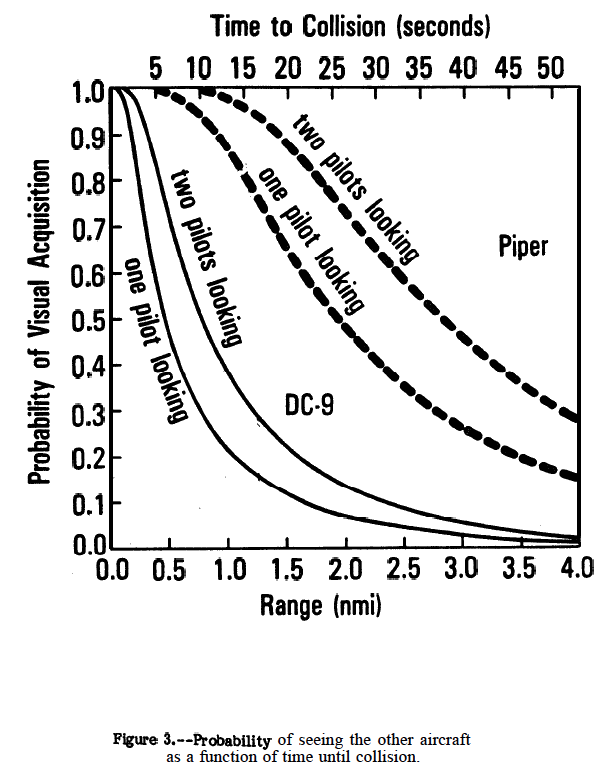
Probability of seeing the other aircraft as a function of time, (NTSB Aircraft Accident Report, Figure 3)
Source: NTSB Aircraft Accident Report, PB87-910409, pgs. 14 - 15
In 1991, the Australian Transport Safety Bureau (ATSB) published a research report titled “Limitations of the See-and-Avoid Principle.” The report discusses the role of the see-and-avoid concept in preventing collisions and some of its inherent limitations:
Cockpit workload and other factors reduce the time that pilots spend in traffic scans. However, even when pilots are looking out, there is no guarantee that other aircraft will be sighted. Most cockpit windscreen configurations severely limit the view available to the pilot. The available view is frequently interrupted by obstructions such as window-posts which totally obscure some parts of the view and make other areas visible to only one eye.
Source: Limitations of the See-and-Avoid Principle, pg. vii
Visual scanning involves moving the eyes in order to bring successive areas of the visual field onto the small area of sharp vision in the centre of the eye. The process is frequently unsystematic and may leave large areas of the field of view unsearched.
Source: Limitations of the See-and-Avoid Principle, pg. vii
The physical limitations of the human eye are such that even the most careful search does not guarantee that traffic will be sighted. A significant proportion of the view may be masked by the blind spot in the eye, the eyes may focus at an inappropriate distance due to the effect of obstructions as outlined above or due to empty field myopia/ in which, in the absence of visual cues/ the eyes focus at a resting distance of around half a metre. An object which is smaller than the eye’s acuity threshold is unlikely to be detected and even less likely to be identified as an approaching aircraft.
Source: Limitations of the See-and-Avoid Principle, pg. vii
The human visual system is better at detecting moving targets than stationary targets, yet in most cases, an aircraft on a collision course appears as a stationary target in the pilot’s visual field. The contrast between an aircraft and its background can be significantly reduced by atmospheric effects, even in conditions of good visibility.
Source: Limitations of the See-and-Avoid Principle, pg. vii
An approaching aircraft, in many cases, presents a very small visual angle until a short time before impact. In addition, complex backgrounds such as ground features or clouds hamper the identification of aircraft via a visual effect known as ‘contour interaction’. This occurs when background contours interact with the form of the aircraft, producing a less distinct image. Even when an approaching aircraft has been sighted, there is no guarantee that evasive action will be successful.
Source: Limitations of the See-and-Avoid Principle, pg. vii
A traffic search in the absence of traffic information is less likely to be successful than a search where traffic information has been provided because knowing where to look greatly increases the chance of sighting the traffic (Edwards and Harris 1972). Field trials conducted by John Andrews found that in the absence of a traffic alert, the probability of a pilot sighting a threat aircraft is generally low until a short time before impact. Traffic alerts were found to increase search effectiveness by a factor of eight. A traffic alert from ATS or from a radio listening watch is likely to be similarly effective (Andrews 1977, Andrews 1984, Andrews 1987).
Source: Limitations of the See-and-Avoid Principle, ¶2.6.1
7
Improving "their" situational awareness
Think of this as "defensive driving" for aviation: the more predictable your flight path, the less likely someone is to try to occupy the same space at the same time. This means flying published routes, flying standard traffic patterns, using hemispheric altitudes, and generally flying "by the book."
Following the AIM, chapter 4, Air Traffic Control, section 3, execute pattern entries and departures for the runway in use appropriate to the airport configuration and information depicted.
Source: AC 90-48D, ¶4.3.1.
Perhaps the highest threat arena for many higher speed jets is the traffic pattern at a nontowered airport. Keep the visual pattern entry in mind, you may have airplanes entering downwind from a 45° angle. A common technique is for a light aircraft to cross overhead the airport at a "higher" altitude in preparation for a descent into the light aircraft pattern, which is normally at 1,000 feet AGL. If your jet pattern is at 1,500 feet AGL (as it usually is), the "higher" altitude could be where you are.
8
Improving your visual scanning techniques
Effective scan patterns
Effective scanning is accomplished with a series of short, regularly spaced eye movements that bring successive areas of the sky into the central visual field. Each movement should not exceed 10 degrees, and each area should be observed for at least 1 second to enable detection.
Source: AC 90-48D, ¶4.2.4.
- Anticipate the target in the location and ranges you are searching;
- Locate a sizable, distant object (e.g., a cloud formation, mountain peak, prominent landmark, building or pier) that is within the range of the anticipated target, and focus your eyes on it as you begin each scan pattern;
- Refocus frequently on a distant point as you begin each new scan;
- Allow three to five seconds for your saccadic eye movement to suppress before shifting your search to the block of airspace around the object; and,
- Vary distances to ensure a thorough scan and to reduce visual fatigue.
Source: Collision Avoidance, pg. 6
Most of the references advocate a side-to-side or front-to-back scanning pattern which I suppose is okay. What I grew up using, from day one in a very busy hornets nest of T-37, T-38, and F-5 aircraft all sharing the same air patch, was a bit different:
- Eyes where you are headed. Spend 90% of your visual scanning time on where the airplane is going. Sure we aren't doing any combat maneuvering in our business, but we are often turning, climbing, and descending. That's where your focus needs to be.
- Pick a far object, jump around from there. Pick something at a distance, a cloud or an object on the ground, and give your eyes a second or two to clearly see it. Then jump from spot to spot where you expect the threat to be, keeping your distant focus intact.
- Head on a swivel. A stationary object on the windscreen is headed right for you but you have the least chance of seeing it until it fills your windscreen. Improve your odds by moving your head. The motion and change in perspective could produce the motion your eyes need to see.
- Look Askance. Include your peripheral vision, especially at night. Realize you have a blind spot directly in front of view at night.
Peripheral vision can be most useful in spotting collision threats from other aircraft. Each time a scan is stopped and the eyes are refocused, the peripheral vision takes on more importance because it is through this element that movement is detected. Apparent movement is almost always the first perception of a collision threat, and probably the most important, because it is the discovery of a threat that triggers the events leading to proper evasive action. It is essential to remember, however, that if another aircraft appears to have no relative motion, it is likely to be on a collision course with you. If the other aircraft shows no lateral or vertical motion, but is increasing in size, take immediate evasive action.
Source: AC 90-48D, ¶4.2.5.
Mental Mind Set
Most importantly, the eye is vulnerable to the vagaries of the mind. We can ‘see’ and identify only what the mind permits us to see.
Source: Collision Avoidance, pg. 7
Our brains tend to be stronger than our eyes and can often fool us into seeing empty space because that is what we expect. It may be helpful to think there is an airplane out there even if you suspect there is not.
Glasses for Acuity and the Sun
As we get older our eyes will naturally lose acuity and the ability to accommodate quickly. It may become natural to squint because narrowing one's eye lids will improve the center focus. (If you wear glasses you can prove this by attempting to read a distant road sign that is just out of focus without your glasses. Attempt to read the sign through the narrow hole formed by your index finger curled into a circle.) The problem with squinting, however, is it reduces the total amount of information. If you need glasses to see without squinting, you should wear glasses.
To accept what we see, we need to receive cues from both eyes (binocular vision). If an object is visible to only one eye, but hidden from the other by a windshield post or other obstruction, the total image is blurred and not always acceptable to the mind. Therefore, it is essential that pilots move their heads when scanning around obstructions.
Source: Collision Avoidance, pg. 7
Glare occurs when unwanted light enters the eye. Glare can come directly from the light source or can take the form of veiling glare, reflected from crazing or dirt on the windscreen. Direct glare is a particular problem when it occurs close to the target object such as when an aircraft appears near the sun. It has been claimed that glare which is half as intense as the general illumination can produce a 42 per cent reduction in visual effectiveness when it is 40 degrees from the line of sight. When the glare source is 5 degrees from the line of sight, visual effectiveness is reduced by 84 per cent (Hawkins 1987). In general, older pilots will be more sensitive to glare.
Source: Limitations of the See-and-Avoid Principle, ¶2.3.3.
Sun glasses that reduce glare can greatly improve your odds of spotting threats.
The eye, and consequently vision, is vulnerable to many things including dust, fatigue, emotion, germs, fallen eyelashes, age, optical illusions, and the effect certain medications. In flight, vision is influenced by atmospheric conditions, glare, lighting, windshield deterioration and distortion, aircraft design, cabin temperature, oxygen supply (particularly at night), acceleration forces and so forth.
Source: Collision Avoidance, pg. 7
9
In case you were wondering
The prototypical drawing of vision angle versus closure time comes from an Air Force drawing in the seventies showing a "beak to beak" engagement with an F-4 Phantom II and was made famous by a 1986 issue of "Aviation Safety Digest." All that is well and good but you are unlikely to find yourself head-on with an Air Force fighter from the seventies. So I've recalculated everything base on flying toward a Cessna 172 flying on downwind at 100 knots while you are doing 200 knots for a closure speed of 300 knots.
Using a Cessna 172 as the slow/small aircraft, which has a wingspan of 34 feet, we see our overtake speed is:
So, assuming we are viewing the monitor from 24 inches and it draws the image of the Cessna accurately, our time to impact while overtaking the airplane is as follows:
| Distance to Aircraft | Wing Span as Seen on Screen | Time to Impact |
| 163 feet | 5 inches | 0.32 seconds |
| 204 feet | 4 inches | 0.40 seconds |
| 272 feet | 3 inches | 0.54 seconds |
| 408 feet | 2 inches | 0.81 seconds |
| 816 feet | 1 inch | 1.61 seconds |
Thanks to Simon Hedderman for help with the math!
References
(Source material)
Advisory Circular 90-48D, Pilot's Role in Collision Avoidance, 4/19/16, U.S. Department of Transportation
Advisory Circular 91-70B, Oceanic and International Operations, 10/4/16, U.S. Department of Transportation
Aeromedical Training for Flight Personnel, Department of the Army Field Manual 3-04.301, 29 September 2000
Collision Avoidance, Methods to Avoid the Risk, European Aviation Safety Agency (EASA), Safety Promotion Leaflet, GA-1, Jan 2010.
Collision Avoidance Must Go Beyond "See and Avoid" to "Search and Detect", Flight Safety Digest, May 1997
Jeppesen Airway Manuals
Limitations of the See-and-Avoid Principle, Australian Transport Safety Bureau, April 1991.
NTSB Aircraft Accident Report, PB87-910409, Collision of Aeronaves de Mexico, S.A., McDonnell Douglas DC-9-32, XA-JED and Piper PA-28-181, N4891F Cerritos, California, August 31, 1986
United Kingdom Civil Aviation Authority Safety Sense Leaflet 13, Collision Avoidance, February 2010
